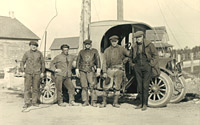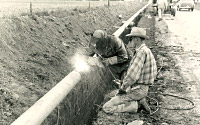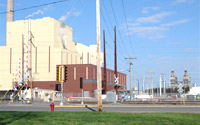WPS began in 1883 as the
Oshkosh Gas Light Company. It was incorporated as Wisconsin Public Service
in 1922. And it was first listed on the New York and Midwest stock exchanges in 1953.
Follow how we've grown and changed in this historic timeline:
1883-1927

- 1883
- A small gas company in Oshkosh was formed.
- 1885
- Oshkosh Gas Light Company obtained a franchise to begin electric service. It was the first combined gas and electric company.
- 1910
- The first true long-distance transmission in what would become Wisconsin Public Service territory was a 69.000-volt line strung on steel towers between the High Falls hydro plant and Green Bay.
- 1913
- Manufactured natural gas service had been expanded from Green Bay through Allouez and into De Pere.
- 1917
- The first really large steam generating plant was built in Wisconsin Public Service's territory. It was built in Manitowoc by Wisconsin Securities. A second plant of the same size was added in 1920. These were the direct result of war-related industrial needs.
- 1919-1973
- Wisconsin Public Service operated bus systems in many of the cities it served. Some of these had evolved from earlier streetcar systems the company and its predecessors had operated. In October 1972, Wisconsin Public Service asked the state Public Service Commission for permission to sell the bus service in Green Bay, the only remaining bus system it was operating.
- 1920s
- This decade saw a spurt of hydro development on the Wisconsin and Peshtigo rivers, including plants at Alexander, Johnson Falls, Caldron Falls and Sandstone Rapids.
- Late 1920s
- Vehicle manufacturers began custom-building utility vehicles (previously utilities used whatever was available, in any color, and customized the vehicles themselves). Wisconsin Public Service kept up with the innovations and improvements introduced by the designers.
- Sep 18, 1922
- Oshkosh Gas Light Company was renamed Wisconsin Public Service Corporation. The company was owned by the Wisconsin Securities Company, which bought and sold utility properties. Shortly after being renamed, Wisconsin Public Service was merged with five other utilities owned by Wisconsin Securities Company. The areas served included Oshkosh, Green Bay, Sheboygan and Manitowoc.
- 1925
- Wisconsin Public Service merged with Northeastern Power Company. This added service areas in Oconto, Peshtigo, Collins, Lena, Pembine, and other locations.
- 1927
- Wisconsin Public Service built a two-unit coal-fired plant on the Fox River in Green Bay. Originally called the Public Service Bayside plant, it was later renamed the J.P. Pulliam plant to honor one of the company's long-time presidents. At the time it was constructed, its capacity of 20,000 KW was considered astonishing. In fact, the company had to make an effort to build consumer load to use the electricity!
Back to top
1930-1954

- 1930s
- A trend toward interconnection of Midwest utilities began. The trend accelerate after World War II.
- Jun 5, 1933
- Wisconsin Public Service merged with Valley Electric Company, adding service areas in Wausau, Merrill, Stevens Point, Tomahawk, Antigo, Rhinelander and Waupaca.
- 1938
- Wisconsin Public Service completed construction of a new hydro plant at Grandfather Falls. Located on the Wisconsin River, this plant has a capacity of 17,420 KW.
- 1938
- Wisconsin Public Service completed construction of a new hydro plant in Tomahawk. Located on the Wisconsin River, this plant has a capacity of 2,600 KW.
- 1943
- Pulliam unit 3, a 30,000 KW unit, was built. This was just before the start of U.S. involvement in WWII. If it had not been built then, it might not have been built until after the war, because of government allocation of vital supplies. If it hadn't gone into service in 1943, the Wisconsin Public Service system would probably have faced power shortages during the war.
- 1947
- Pulliam unit 4, a 30,000 KW unit, was built. There were construction delays because of shortages of materials. But demand for electricity had doubled since 1939, which meant the capacity of the new unit was all but absorbed as soon as it went online.
- 1947
- Wisconsin Public Service began machine billing with IBM equipment. Previously bills were handwritten.
- 1947-1949
- Wisconsin Public Service faced serious power outages. Dry weather caused low output from hydro plants, and shortages were occurring at interconnected companies as well. The PSCW gave utilities the right to curtail service in emergencies. Some customers were advised to shift their energy use to off-peak hours. Commercial lighting was restricted.
- Sep 1949
- Pulliam unit 5, at 50,000 KW, went into service.
- 1949
- Wisconsin Public Service became the first public utility to join in sponsorship of Trees for Tomorrow.
- 1950s
- Wisconsin Public Service began installing electrostatic precipitators on coal plant stacks to remove fly ash resulting from burning coal.
- 1950
- Natural gas pipeline arrived to the Wisconsin Public Service territory. Until this time, all natural gas had been manufactured gas: coal gas, coke oven gas, water gas, propane-air gas or a mixture of these gases.
- 1951
- Pulliam unit 6, at 62,500 KW, went into service.
- 1952
- Extension of service to the rural areas of Wisconsin Public Service territory was 98% complete. The average rural customer used more than 3,000 kWh annually. The average residential customer used about 2,000 kWh annually.
- May 1953
- Wisconsin Public Service common stock was first listed on the New York and Midwest stock exchanges.
- 1954
- Weston unit 1, at 60,000 KW and located near Wausau, went into service. It was the first steam generating plant to be built in Wisconsin Public Service territory, and the first to be constructed outside of Green Bay in 25 years.
- 1958
- Pulliam unit 7, at 75.000 KW, went into service.
Back to top
1960-1982

- 1960
- Weston unit 2, at 75,000 KW, went into service.
- 1961
- Wisconsin Public Service joined Madison Gas and Electric and Wisconsin Power and Light to form the Wisconsin Power Pool (WPP). The objective was to coordinate planning of future generating capacity. Shortly after, the WPP companies joined Wisconsin Electric and Upper Peninsula Power Company to form the Wisconsin-Upper Michigan System (WUMS). The objective of WUMS was to increase reliability by gaining protection from large-scale outages, and to coordinate scheduling of new generation and transmission facilities, along with maintenance of the equipment involved.
- 1963
- By this time, 58% of Wisconsin Public Service customers were heating their homes with natural gas.
- 1964
- WUMS and other regional groups came together to organize the Mid-America Interpool Network (MAIN). MAIN further increased reliability of service throughout the region and enabled member companies to use to their best advantage any surplus power that became available in the system.
- 1965
- Pulliam unit 8, at 125,000 KW, went into service.
- 1967
- With corporate offices divided among Milwaukee, Oshkosh and Green Bay, the Wisconsin Public Service directors voted to move all headquarters to Green Bay, effective 1970. Green Bay was the largest city in the utility's service area and was centrally located. With approval of the Public Service Commission of Wisconsin, in 1969 the company began constructing a seven-story office building on the banks of the Fox River.
- 1969-1973
- Wisconsin Public Service built and used peaking plants at Weston and West Marinette. These were needed to supplement the company's power supply during construction of the Kewaunee Nuclear Power Plant.
- 1970
- 81% of Wisconsin Public Service customers were heating their homes with natural gas. Unfortunately, depleted natural gas wells, difficulty developing new sources of natural gas, and the Arab Oil Embargo of 1973 led to restricted gas supplies across the nation. Utilities were forced to deny new natural gas service to customers. This lasted until 1978.
- 1970s
- Wisconsin Public Service began a 10-year program to improve the safety and reliability of its gas operations. It did this by replacing all cast iron and bare steel main piping with polyethylene plastic piping or specially coated and wrapped steel piping.
- 1970s
- Wisconsin Public Service reached high levels of fly ash removal at its plants. Pulliam units 3-8 had 98.7% efficiency; Weston 1 and 2 had a removal efficiency of 99%, and West unit 3 had 99.5% efficiency.
- Jul 23, 1974
- Kewaunee Nuclear Power Plant reached full power for the first time.
- 1975
- Columbia unit 1, jointly owned by Wisconsin Public Service and Wisconsin Power and Light, went online.
- 1976
- Wisconsin Public Service ended an era of selling appliances in all of its office locations. Originally, utilities sold appliances because they were actually promoting the use of energy. This made sense early on, because increased use helped create the need for new generating equipment, which in turn made generation more efficient and often reduced costs. But in the 1970s, the utilities turned their attention to helping customers conserve energy, based on rising energy costs and energy shortages.
- 1978
- Columbia unit 2, jointly owned by Wisconsin Public Service and Wisconsin Power and Light, went online.
- 1978
- Wisconsin Public Service began an energy audit program by which customers could call for recommendations on energy conservation and inspections to help determine energy-efficient improvements. Later, the company joined a state-mandated Residential Conservation Service program, with a similar purpose.
- 1981
- Weston unit 3, at 300 MW, went into service.
- 1982
- Wisconsin Public Service introduced a new bill, with more information to help customers concerned with energy conservation.
Back to top
1993-2015

- 1993
- Wisconsin Public Service was the first utility in the state to hire Customer Assistance Advisors. These employees, with Human Services backgrounds, are advocates for low-income customers, connecting these customers with community assistance, and state and federal programs.
- 1994
- Wisconsin Public Service formed a holding company, named WPS Resources Corporation. WPS Energy Services, Inc., a non-regulated energy services provider, was also formed in 1994, under the WPS Resources holding company. WPS Energy Services would serve a growing number of customers with choice in the Midwest and Northeastern U.S. and Canada.
- 1996
- Wisconsin Public Service began preparing for Y2K.
- 1996
- Wisconsin Public Service introduced its SolarWise® for Schools program. The program helps schools teach students about the opportunities solar energy holds.
- 1998
- WPS Resources Corporation acquired Upper Peninsula Power Company.
- Feb 1999
- Wisconsin Public Service and other utilities in Minnesota and Wisconsin announced the formation of Nuclear Management Company. NMC would have a goal of sustaining long-term safety, optimizing reliability and improving the operational performance of the nuclear generating plants.
- Jun 1999
- Fourteen large wind turbines began making electricity for customers of Wisconsin Public Service. The final wind turbine was connected to the Wisconsin Public Service electrical system on June 26, completing the 9 megawatt project in the Kewaunee County Town of Lincoln.
- Sep 1999
- Wisconsin Public Service began installing automated meter reading on customers' meters.
- Oct 2000
- Wisconsin Public Service announced the company had joined the American Transmission Company (ATC), a state-based electric transmission company formed as a result of the Reliability Act 2000. In return for its transfer of assets, Wisconsin Public Service will receive a proportionate ownership share in ATC.
- Nov 2000
- Wisconsin Public Service and Minnesota Power proposed to build an electric transmission line from Duluth, Minnesota, to Wausau, Wisconsin. The line would greatly enhance the reliability and safety of the state's electric system. The new line would enable the utilities to bring much-needed power into the state from available sources from the north and from the west of Duluth.
- Mar 2001
- The Public Service Commission of Wisconsin approved the merger of WPS Resources and Wisconsin Fuel and Light. The official merger date would be April 1, 2001.
- 2001
- Steam generators at the Kewaunee Nuclear Power Plant were replaced.
- Sep 2002
- To help meet growing electric demand, Wisconsin Public Service announced intentions to add a 500-megawatt coal-fired electric generator at the Weston Power Plant site.
- Dec 2004
- WPS Resources Corporation (presented Wisconsin Governor James Doyle with a deed for approximately 12,000 acres of land donated and sold to the state by Wisconsin Public Service. The utility, no longer needing the land for utility operations, wanted to ensure that the care and stewardship it had shown for the area would continue.
- Jul 2005
- Wisconsin Public Service and Wisconsin Power and Light Company transferred ownership of the Kewaunee nuclear power plant to Dominion Energy Kewaunee, a subsidiary of Dominion Resources. The companies sold their interest in the plant to relieve their customers and shareholders of the risk and cost inherent in owning a single nuclear plant. Power from the plant would continue to be purchased for customers.
- Apr 2006
- WPS Resources completed the purchase of the Michigan gas operations of Aquila, Inc. WPS Resources named this new subsidiary Michigan Gas Utilities.
- Jul 2006
- WPS Resources completed the purchase of the Minnesota gas operations of Aquila, Inc. WPS Resources named this new subsidiary Minnesota Energy Resources.
- Feb 2007
- WPS Resources Corporation completed its merger with Peoples Energy Corporation. WPS Resources changed its name to Integrys Energy Group, Inc. Regulated subsidiaries of Integrys Energy Group now include Wisconsin Public Service, Upper Peninsula Power, Michigan Gas Utilities, Minnesota Energy Resources, Peoples Gas and North Shore Gas. Its non-regulated subsidiary is Integrys Energy Services.
- 2008
- Weston unit 4, at 525 MW, went into service. The plant won the 2008 Plant of the Year Award from POWER magazine and Power Engineering's 2008 Best Coal-Fired Project award.
- 2009
- The Crane Creek Wind Farm was completed. The wind warm can produce 99-mega-watts of electricity.
- 2010
- High Falls and Grand Rapids hydroelectric power plants turn 100 years old.
- 2013
- Wisconsin Public Service purchased Fox Energy Center, a natural gas fueled electric generating unit. It is capable of producing 593-megawatts.
- 2015
- Integrys Energy Group, Inc. and its operating companies were acquired and now do business as WEC Energy Group. WPS continues to operate as a separate utility under the new parent company.
Back to top